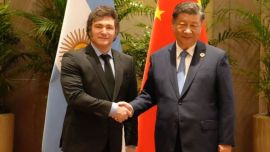The stories of Clara Allyn Benitz and Mary Elizabeth Gorman Sewell are part of an exhibition inaugurated in Washington this month that celebrates an "epic" journey long forgotten: the more than 60 school teachers who between 1869 and 1898 travelled from the United States to Argentina to found schools or reorganise centres of learning nationwide.
"I’m proud that they’ve been recognised," says Peter, the great-grandson of Clara, who graduated from a teaching college in Winona, Minnesota, and who arrived in Argentina in 1878 on a contract to assist her sister Frances at a school in Paraná. Love would later take Allyn Benitz across the river to Santa Fe.
The exhibition at Argentina’s Embassy in Washington includes over 40 digitised and restored portraits, along with maps of the travels of the pioneers from New England, Ohio, New Mexico and other parts of the United States who travelled to remote South American jungles, mountains and pampas.
"Almost all of them complied with the requisites of the Argentine government – they were single, attractive, young female school teachers from good families," said Laura Ramos, the Argentine writer of the bestseller Las Señoritas that inspired the exhibition.
At the recent Feria Internacional del Libro de Buenos Aires, Argentina’s world-renowned book fair, where she had just picked up the Primer Premio de la Crítica 2021-2022 prize, Ramos enthusiastically related the tales she accidentally discovered when taking refuge from a rainy afternoon in the Sarmiento Museum.
"There I ran into a dress identical to that used in Little Women and found out about their story. I began researching until I found the letters and the intimate diaries of many of the school teachers at Duke University, North Carolina," she recalled.
"In four years of research I found many more letters in Rutgers University, Jersey, the archives of the astronomer Benjamin Gould and other archives of the United States and Argentina."
Borges, lesbian love and syphilis
Some discoveries made a special impact.
From the intimate diary of the cousin of the Allyn sisters, Ramos found out that the English grandmother of Jorge Luis Borges, Frances Ann Haslam, had lodged many of the schoolteachers at her home in Paraná.
"They were friends," said the author.
She also found about a lesbian relationship in Mendoza between Mary Morse and Margaret Collord, who had previously travelled as a missionary to Montevideo.
"After their deaths, the irate nephew of Morse travelled from the United States to make a bonfire of their letters and books which had shocked the people," recalls Ramos. "They had asked to be buried together under a tombstone in Mendoza cemetery reading: 'They were not separated in their eternal rest.'”
Ramos also found out that Agnes Trégent, married to a Frenchman, had died of paretic neuro-syphilis but "it was said that she had died of cerebral paralysis to protect the prestige of the school teachers."
Addie Stears died of typhoid fever in Paraná at the age of 22 and could not be buried in the cemetery as a Protestant, a sign of the religious discrimination which many schoolteachers suffered.
In Córdoba, young Catholics threw stones and spat at Frances Armstrong.
Pedagogues with bowties
Undoubtedly, Ramos’ favourite story is that of Mary Graham, "the great pedagogue who gave classes in a bowtie."
The teacher took her pupils on long walks and proposed debates and discussions.
"She did not dictate but would ask them: 'That’s what Spencer says, what do you think?'," relates Ramos.
It is not surprising that Las Señoritas – with their adventures, passionate love affairs, religious clashes and tragic fates – will soon be translated into English or converted into a television series.
"My agent is negotiating both things," confirmed Ramos.
For this fan of Louise May Alcott, "it was a great thrill" that Mary Mann – wife of the great US educator Horace Mann, friend of Domingo Sarmiento and the main force behind recruiting the school teachers – should be close to the Alcotts.
"Louisa May was then 33 but if she had been 10 years younger, she could have come. Indeed the entire ideology of the schoolteachers is the same as sustained in Little Women: hers was the spirit of that epoch, naturalist and proto-feminist we might say," said the author.
Although only 22 of "Sarmiento’s schoolmarms" settled down in Argentina when their contracts had finished, Ramos has no doubt as to the relevance of their contribution.
"They abolished corporal punishment and learning by heart, encouraging physical exercise and discussion. They proposed games as a central element, education for both sexes and all classes and job training for orphans and beggars,” she explained.
“Current teaching in Argentina is modelled on the parameters of those schoolteachers."
related news
by Alina Dieste, AFP






















Comments